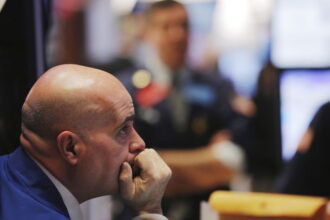Michael M. Santiago/Getty Images
We take the good, and we take the bad—but the stock market is taking it to extremes.
An eventful first quarter ended on Friday with investors sitting on major gains, if they invested in growth stocks. The
Russell 1000 Growth
index rose nearly 14% in the first three months of 2023, while the value subset of the index barely budged. It was the widest gap between the two benchmarks since the first quarter of 2020.
What’s causing the divergence? Financials are the largest sector of the value index, and the group has been hit hard by turmoil in the banking sector. The technology, communication-services, and consumer-discretionary sectors, big in growth, are up by double digits so far in 2023, as investors bet that the Federal Reserve will soon end its tightening campaign.
In fact, the market is now acting as if the woes in the banking sector will stay in the banking sector. Over the past week, the tech-heavy
Nasdaq Composite
added 3.4%, while the
Dow Jones Industrial Average,
with a fifth of its holdings in financials, advanced 3.2%. The
S&P 500
index rose 3.5%.
It’s always possible the market isn’t simply turning Pollyannaish. Silicon Valley Bank and Signature Bank had idiosyncratic issues that led to their downfalls, while the Fed and other financial regulators have the tools to prevent a wider crisis of confidence in the nation’s banks. If nothing else, it seems clear that we’re not heading for a systemwide meltdown akin to 2008.
But there doesn’t need to be a full-blown financial crisis for the market to feel the impact of the banking woes. It already seems clear that lending standards will tighten and that there will be less capital available to businesses and start-ups. And less credit expansion means slower economic growth. Goldman Sachs’ Jan Hatzius estimates that the impact of tighter credit will subtract 0.4 percentage point of U.S. gross-domestic-product growth in 2023, taking his estimate down to 1.1%.
Nor are tighter lending standards a new trend. The Fed’s Senior Loan Officer Opinion Survey on Bank Lending Practices is completed four times a year. The fourth-quarter 2022 edition showed tightening terms for bank loans across the board—for large and small businesses, for commercial and residential real estate, for credit-card and auto loans. Loan officers expected standards to continue to tighten—and that was before the bank turmoil.
The next lending survey won’t be available until early May, but other anecdotal and market-based measures suggest that the tightening is already happening. Deutsche Bank’s high-frequency financial conditions index has tightened to a level that has typically been associated with recessions, while the bond market appears shut to high-yield borrowers. Leveraged loans and private lending also look to have become less available—and more expensive.
Jim McVeigh, CEO of artificial-intelligence deal sourcing platform Cyndx, which analyzes data on millions of private companies and transactions, says creditors have been putting more onerous rules on loans while reducing their duration. He has been seeing some companies being charged 9%, when they used to borrow at rates below 5%.
“All of those things are not favorable to the borrower,” he says.
Or for the stock market.
Write to Nicholas Jasinski at [email protected]
Read the full article here










